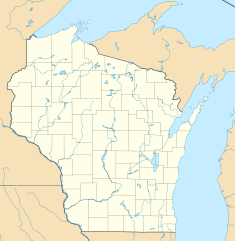
Back Casa Taliesin Catalan Taliesin (Atelier) German Casa Taliesin Spanish Taliesin (villa) French Taliesin (studio) Croatian Taliesin (edificio) Italian Taliesin (villa) Dutch Taliesin East Portuguese Taliesin East Romanian Талиесин (резиденция) Russian
| Taliesin | |
|---|---|
 Taliesin III's drafting studio (left) and living quarters (right) as seen from the crown of its hill | |
 Interactive map showing Taliesin's location | |
| Location | 5607 County Road C, Spring Green, Wisconsin, U.S. 53588 |
| Coordinates | 43°08′28″N 90°04′14″W / 43.14111°N 90.07056°W |
| Area | 37,000 square feet (3,400 m2) (interior of main building), 75,000 square feet (7,000 m2) (interior of all buildings), 600 acres (240 ha) (estate) |
| Built | 1911–1959 |
| Visitors | 25,000[1][2] (in 2023) |
| Governing body | Frank Lloyd Wright Foundation |
| Criteria | Cultural: (ii) |
| Designated | 2019 (43rd session) |
| Part of | The 20th-Century Architecture of Frank Lloyd Wright |
| Reference no. | 1496-003 |
| Region | Europe and North America |
| Designated | March 14, 1973 |
| Reference no. | 73000081[3] |
| Designated | January 7, 1976[3] |
Taliesin (/ˌtæliːˈɛsɪn/ tal-ee-ess-in;[4] sometimes known as Taliesin East,[5][6] Taliesin Spring Green, or Taliesin North after 1937) is a house-studio complex located 2.5 miles (4.0 km) south of the village of Spring Green, Wisconsin, United States. Developed and occupied by American architect Frank Lloyd Wright, the 600-acre (240 ha) estate is an exemplar of the Prairie School of architecture. Wright began developing the estate in 1911 on land that previously belonged to his maternal family.
Wright designed the main Taliesin home and studio with his mistress, Mamah Borthwick, after leaving his first wife and home in Oak Park, Illinois. The design of the original building was consistent with the design principles of the Prairie School, emulating the flatness of the plains and the natural limestone outcroppings of Wisconsin's Driftless Area. The structure (which included agricultural and studio wings) was completed in 1911. The name Taliesin, meaning "shining brow" in Welsh, was initially used for the first building, which was built on and into the brow of a hill; it was later extended to the entire estate.
Over the course of Wright's occupancy, two major fires led to significant alterations; these three stages are referred to as Taliesin I, II, and III. In 1914, after a disgruntled employee set fire to the living quarters and murdered Borthwick and six others, Wright rebuilt the Taliesin residential wing, but he used the second estate only sparingly, returning there in 1922 following the completion of the Imperial Hotel, Tokyo. An electrical fire gutted Taliesin II's living quarters in April 1925, and he rebuilt it later that year. Wright lost the house to foreclosure in 1927 but was able to reacquire it the next year, with financial help from friends. In 1932, he established a fellowship for architectural students at the estate. Taliesin III was Wright's home for the rest of his life, although he began to spend the winters at Taliesin West in Scottsdale, Arizona, upon its completion in 1937. Many of Wright's acclaimed buildings were designed at Taliesin, including Fallingwater, the Jacobs I house, the Johnson Wax Headquarters, and the Solomon R. Guggenheim Museum. Wright, who was also an avid collector of Asian art, used Taliesin as a storehouse and private museum.
Wright left Taliesin and the 600-acre Taliesin Estate to the Frank Lloyd Wright Foundation (founded by him and his third wife in 1940) upon his death in 1959. This organization oversaw renovations to the estate until 1990, when a nonprofit organization known as Taliesin Preservation Inc. (TPI) took over responsibility. TPI began renovating the estate to repair deterioration that took place over the years. The Frank Lloyd Wright Foundation and Taliesin Preservation operate numerous public programs on the campus, and the farm is still in use today by tenant farmers. The Taliesin estate was designated a National Historic Landmark in 1976, and it was listed as a World Heritage Site in 2019 as part of a group of eight listings known as "The 20th-Century Architecture of Frank Lloyd Wright".
- ^ Cite error: The named reference
Milan 2024was invoked but never defined (see the help page). - ^ Verburg, Steven (July 25, 2010). "Amid an Architectural Wonder, a Family Grows". Wisconsin State Journal. Archived from the original on August 29, 2016. Retrieved October 17, 2013.
- ^ a b "National Register Information System". National Register of Historic Places. National Park Service. April 15, 2008.
- ^ "Preserving architectural gem a slow project". The Reporter. Associated Press. May 30, 2004. p. 25. Retrieved November 29, 2024 – via Newspapers.com.
- ^ Campbell, Robert (April 2003). "What becomes a legend most? Restoring Wright's greatest work raises some sticky questions". Architectural Record. Vol. 191, no. 4. pp. 93–96. ProQuest 222157728.
- ^ Yenckel, James T. (February 1, 1987). "Places and Spaces of Frank Lloyd Wright; Other Wright Sites". The Washington Post. p. E01. ISSN 0190-8286. ProQuest 306864489.

